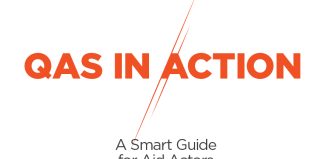Prepared for the Worst: Disaster Risk Reduction initiatives that strengthen local resilience and mitigate future hazard impact
The year 2022 has been one of many natural disasters for Afghanistan, with the already economically fragile country being hit by a drought, flash floods and a devastating earthquake that killed over a thousand people. More than half of Afghanistan’s 39 million people need humanitarian help, of which six million are at risk of famine1.
Fifty-two-year-old Jameela, and many other families living in Sarband village survived more than one natural disaster this last year but live in extremely challenging conditions now. Day to day survival has now become a normal way of life for them as they continue to live in poverty and economic instability. Among the many trials they face, the threat of flash floods looming over their heads is one most difficult to live with. There is constant fear and uncertainty.

Sarband village is positioned between two sources of potential disaster: the Kunar River to the north and the mountains to the south. Both are at risk of either the river over flowing or flash floods.
Jameela and her family have been old residents of Sarband and have personally witnessed the ravaging force of the floods. Residing just at the base of the valley, their house has been particularly vulnerable to flash floods, that occur every spring and summer season.
“Every year Sarband would experience flash floods as the village is located in the southern end of the valley. Our main source of livelihoods, agriculture, is mostly damaged by these floods. We continue to work on our fields though as we have limited working opportunities in the surrounding areas of Sarband.” Despite these trials, Jameela and her families persisted in their agricultural endeavours, contributing to their household income and the welfare of their community. With every flood, their crops and properties were left destroyed. And each time they had to start over from scratch. But the family has remained resilient and forever hopeful.
Every year all of Sarband’s 212 hectares of agricultural land has been at risk of flooding. The risk and impact of these potential disasters has overshadowed the lives of the communities living here. “We start each spring with the fear of being hit by the floods, and with the possibility of not surviving the floods each time. Every year the flood is fiercer than before, and we are always powerless against this natural hazard. We cultivate our land every spring, but the floods destroy half of it. And since our land is our only source of income, we have no choice but to bear this hardship and start over,” shared Jameela. After the floods, all the families clean up the land that has been destroyed every year. It has become an annual activity now. During this time and in the rainy seasons, the children of this village miss out school and stay home. On very rainy days, villagers of Sarband leave their homes and stay at their relatives’ houses which are located at higher grounds and are comparatively safer.
Jameela’s family and many others from the village saw some semblance of hope in December 2022 when Community World Service and its Japanese partners started construction of a protective wall around the village after consulting with the people of Sarband and with technical disaster risk reduction (DRR) experts.
The protective wall aimed at reducing the threat of flash floods to Sarband village. Before the construction of the wall started, Jameela shared her family’s yearly experience of surviving the floods and how it harmed their lands and their lives, with CWSA and its team of experts. “We have tolerated the brunt of these floods for our home is situated at the origin of the valley, and the flood water descends upon us first, before storming towards other residences and fields. I believe that with the erection of this protective wall, the flow of water shall be redirected, protecting our house and other houses from the wrath of the flash floods.” Jameela added happily, “It will be like a miracle for us.” Last year (2021) another humanitarian organisation constructed a weir on the Kunar River to the north of Sarband village, safeguarding the community from the danger of river floods. “Now, with this project, we shall also be secured from the menace of flash floods,” concluded Jameela.
Within a span of three months the construction of the wall was completed. Jameela and her family were very grateful for the wall and how it effectively protecting their home. Similarly, other families in the village benefited from this construction either through cash for work activities as labourers constructing the wall or from reduced flood threats.
The successful construction of the protective wall not only gave a sense of safety and security to the families and farmlands of Sarband village but also infused the entire community with a renewed sense of optimism and confidence. The hard work and commitment of the teams engaged, along with the support of the local community, played a critical role in ensuring this accomplishment.
Under its DRR project with MoFA Japan and CWS Japan, Community World Service Asia is continuing to work towards strengthening the resilience of most vulnerable hazard affected communities in remote areas of Afghanistan. We are closely working with affected communities themselves through direct interventions like this wall construction while also strengthening local capacities through trainings and transfer of technology. Another recent achievement under the project has been the development of a first of its kinds, postgraduate curriculum for the Environmental Faculty of Kabul University.
- Foreign Affairs of Japan (MoFA) & CWS Japan







